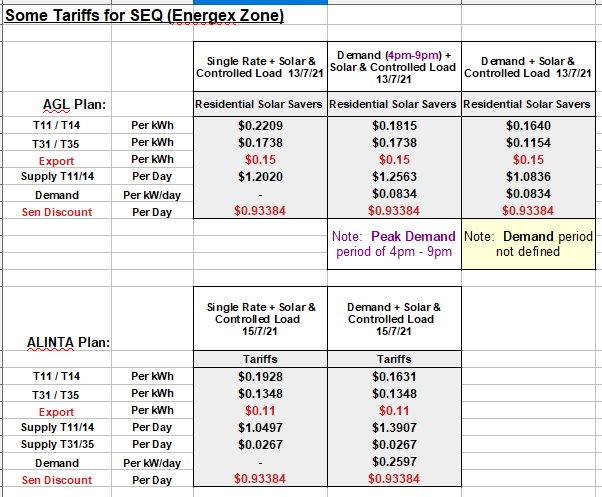Please note the following is not provided as financial advice or as recommendations on electricity plans or retailers. It’s a summary of some of the considerable public content available concerning ongoing reforms to electricity billing and charges in Qld approved in 2020 by the Australian Energy Regulator.
The commentary relates primarily to customers supplied from the SE Qld Energex Network.
The original OP
Importantly a Demand tariff can only be used with a suitable Smart Meter connection. It is not the only option for billing, and the impact if selected for an individual bill will vary, (decrease - except for a heavy user in the evening peak hour electing for a Demand tariff).
This discussion has derived from a published public document detailing the most recent approved 2020-2021 wholesale distribution tariff (TSS) approved for Energex Qld and supply in SE Qld. This is not the same as the agreements between retail customers/householders and their retailer. EG AGL, Origin, Alinta etc.
In Summary
- The national energy regulator approved for 2020-21 revised tariff structures for Ergon and Energex. IE The tariffs used to bill Retailers for electricity supplied to residential and other customers.
- It is up to each retailer to decide how they markup and recover the cost of electricity billed by Energex against each connection, (the Retailer’s customer).
- Ergon customers will need to wait for the Qld Competition Authority to issue it’s final determination for 2021-2022 to find out if and how electricity billing and costs may further change. Currently only at draft.
How electricity is currently being metered and the bill calculated, or how this might change after 01 July 2021, will vary for each customer and Retailer. Energex has a number of different metering arrangements and transition variations. Individual customers may be on a spinning disc accumulation meter, or smart metering. Some smart meters are online logging. Some do not have that access. Each Retailer has a number of fixed term or variable rate plans. Some plans have a fixed contract period and no change. Others are subject to change month to month.
As there are numerous permutations and a multitude of suppliers/contracts - the best way forward is for consumers to individually contact their Retail supplier to confirm their current metering and billing, including default metering. It may also be important to clarify what will happen with any renewal, and if they are going to be upgraded to a smart meter in the near future. Note that smart meters enable the options of Time of Use metering as well as Demand based metering.
Consumers on agreements subject to change on a months notice are most likely to see changes. Those on the Spinning disc mechanical accumulation type meters will see no change until they upgrade to smart meters.
According to Energex a Retailer’s customer Smart metered, can elect to be metered on ToU (time of use metering) or Demand metering (consumption+monthly peak demand). The customer has the choice. It’s up to each Retailer to clarify if a flat single rate retail plan will be offered as an alternative to ToU or Demand based retail plans. The retailer will however be billed on a cost reflective network tariff. For customers ToU tariff options are readily identified for each SE Qld Retailer, as are current fixed flat rate offers.
Whether a householder is better off on a Demand tariff or a TOU tariff is difficult to determine until there is a full 12 month x 30 minute consumption history. Customers with Smart meters have not been provided with real time monitoring, necessary to reliably manage consumption on Demand and ToU based tariffs.
There are likely many questions unanswered. Feel free to share what they might be and what answers you receive. There is very little evident concerning Demand based tariff options on my Retailer’s web resources, although they are clearly aware of the changes from more than a year past. I had to phone to find out more.
Foot notes and selected references:
Qld Govt General
Energex Explanatory Notes to the TSS (Mark’s recommendation as the best guide to what and why!)
https://www.energex.com.au/__data/assets/pdf_file/0004/830488/Energex-TSS-Explanatory-Notes-December-2019.pdf
Community consultation on tariff changes.
The QCOSS (Queensland Council of Social Services) has made several representations in the past. A long but detailed commentary in response to the changes as discussed.
Outline of development of the revised TSS-2019, Tariff Structure Statement and links.
Where documents refer to a 4 digit tariffs in the TSS these are the wholesale/distributor tariffs and rates.




